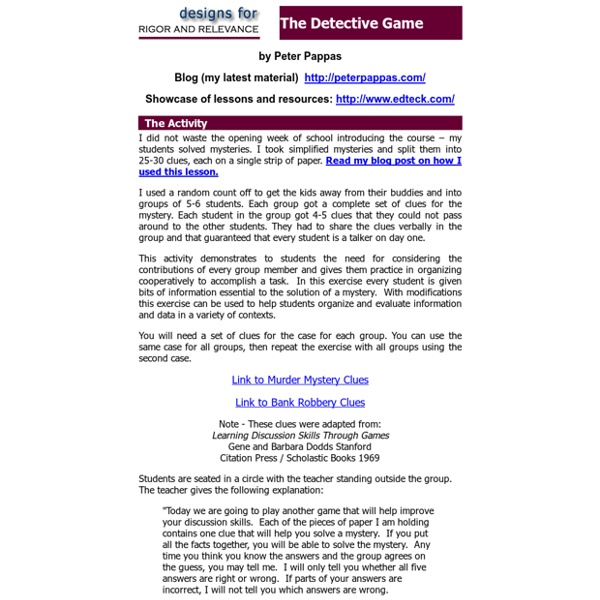Meet Google Drive – One place for all your files
One account. All of Google. Sign in to continue to Google Drive Find my account
Detective Mystery Brain Teasers for Kids
Detective Mystery Brain Teasers for kids are fun to read and solve. Check out our collection of detective mystery stories for kids. These brain teasers have been submitted by our visitors from all around the world.
Two Growth Mind-Set Activities to Help Motivate All Students and Teach Nature...
If you want to start the year building relationships, engaging in inquiry, planting the seeds of growth mindset, and learning about the nervous system...this is for you!!! The inspiration for the first set of activities is based on the NPR story Students' View of Intelligence Can Help Grades while the inspiration for the second of activities is based on the research done at four urban high schools by researchers at the Teachers College, Columbia University. Here is a link to all of the slides.
Pokemon Evolution DIY Kaleidoscope Paper Toy
My kids and I have really been enjoying making Pokemon DIYs recently and we rather love our DIY Paper Toys too. Bring the two together and you get these fantastic never ending Pokemon Evolution DIY kaleidoscope or kaleidocycles – basically, watch your favourite characters, Bulbasaur, Eevee, Charmander and Squirtle, as they evolve….. Pokemon Evolution DIY – Materials
Team-Building Games and Activities for the Classroom
Team-building games and activities are a great tool for helping students learn to work together, listen carefully, communicate clearly, and think creatively. They also give your students the chance to get to know each other, build trust as a community and, best of all, have some fun! Here are 33 team-building activities that will teach your students these skills and more. Watch the video below to see three of our favorite team-building games in action, then read on for more ideas. [embedyt] 1.
Lesson Plans – Search Education – Google
Picking the right search terms Beginner Pick the best words to use in academic searching, whether students are beginning with a full question or a topic of just a few words. View lesson
Creating the Tallest Cup Tower: A STEM Challenge
Guest post by Tracey Graham of Growing a STEM Classroom STEM (Science, Technology, Engineering, and Math) is one of the current “buzz words” in the world of education today even though the STEM philosophy of teaching has been around for a very long time. STEM is all about students learning in a student-centered, question-based, subject-integrated classroom. Hence, what I consider to be good teaching. Remember teaching with cross-curricular themes? STEM is like thematic teaching gone wild!
World Studies HHS: Lesson plan (geography) Zombie Apocalypse Webquest (modified and adapted 2013 from collaborative teacher group on edmodo)
Zombie Apocalypse WebQuest Introduction A huge yet unknown catastrophic event has changed the world as we know it. One of the major results of this event is the spread of zombies across the globe. People all around the world are trying to survive this zombie invasion the best way they can.
Team Building Activities
Google (2016) found, as a result of a massive investigation to find out how to build the perfect team, that psychological safety is the most important element for team work, increased productivity, creativity, and cooperation. See also cooperative learning and teaching. How Many Squares? Puzzle. or Forty Squares Puzzle
Team Building Games for Teachers
Students in classes that operate on a team basis learn more and perform better. Beyond academic achievement, race relations, social skills, class climate, self-esteem and higher-level thinking, all improve dramatically in classes that utilize cooperative learning, according to Dr. Spencer Kagan, the founder of Kagan Cooperative Learning.
Fan-N-Pick
So how does Fan-N-Pick work? Its actually very simple. You need to start with a set of cards for each group of four students.
Three Brain Teasers to Spur Logical Thinking and Collaboration
There are lots of ways to stretch student thinking and get them talking to each other about ideas. One fun way is through riddles that require inductive reasoning, critical thinking and hopefully some good collaboration around student ideas. The three brain teasers below created by TED-Ed have fun visuals and include an explanation at the end. All the videos also include lesson plan ideas to deepen the conversation and start discussion. In this first video about prisoners’ hats the problem set-up ends at 1:35, so stop the video there if you want kids to work on the problem before learning how to solve it. In this zombie bridge problem the set-up ends at 2:00.
Build a Boat (and a classroom culture)
The start of a new school year is fast approaching and as we begin to plan for our first days back with students I thought I’d share one of my favorite first day activities. One of the most important components to a successful modeling classroom is the classroom culture. Modeling teachers need to build the kind of classroom environment where students respect the process of investigation and understand that the process of science learning is as important as arriving at correct answers. We want our students to see value in learning from each other and recognizing it’s okay to not have the best answer the first time you attempt something. In an attempt to instill these ideas from the first day of class I have my students build boats on day one.



